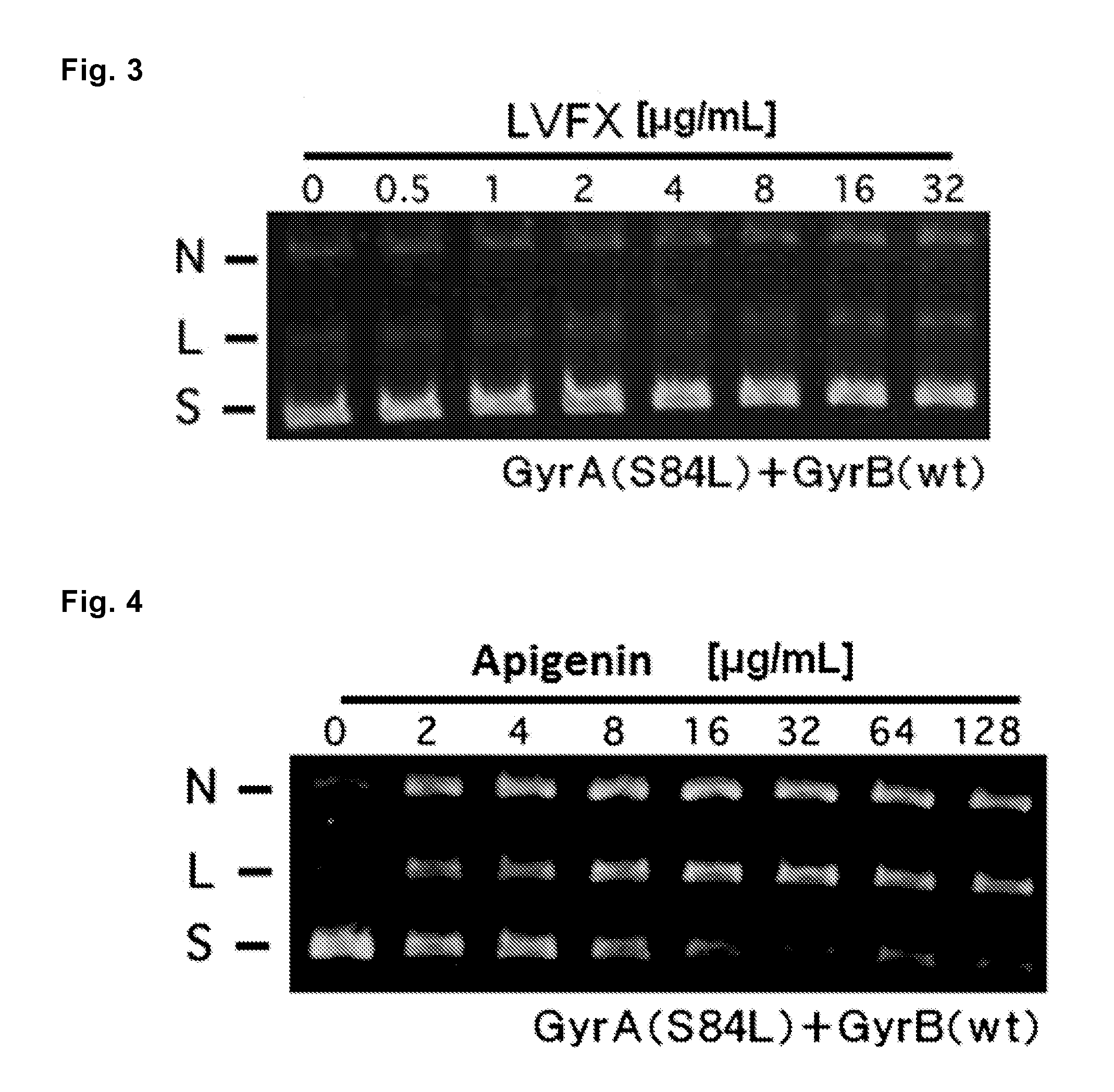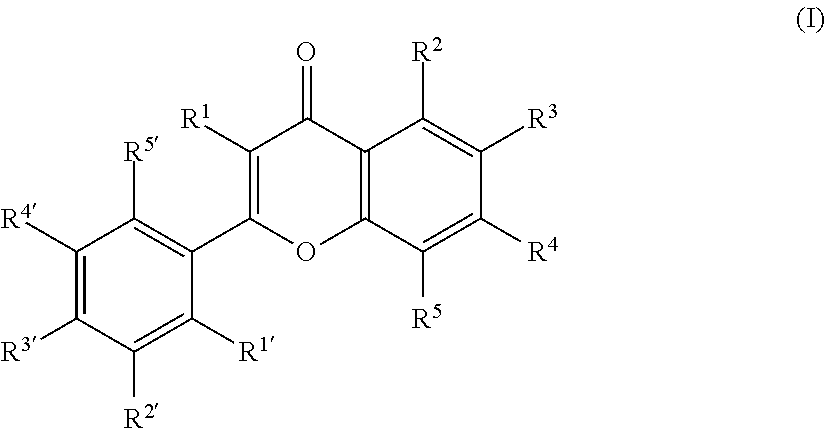Antibacterial agent
a technology of antibacterial agent and antibacterial activity, which is applied in the direction of antibacterial agent, biocide, drug composition, etc., can solve the problems of serious clinical problems, inability to dna replication, and inhibit the dna synthesis of bacteria, and achieves potent antibacterial activity, potent antibacterial activity, and antibacterial activity.
- Summary
- Abstract
- Description
- Claims
- Application Information
AI Technical Summary
Benefits of technology
Problems solved by technology
Method used
Image
Examples
example 1
[0053]Antibacterial activities of 133 kinds of the compounds shown in Tables 1 to 10 mentioned below against Staphylococcus aureus were examined by the following methods.
[0054]The compounds shown in Tables 1 to 10 mentioned below (flavones, isoflavones, flavanones, anthocyanidins, and flavans) were each dissolved in dimethyl sulfoxide (DMSO) at a concentration of 1,024 mg / L. Cation-adjusted MHB was separately prepared by adding magnesium and calcium to MHB (Mueller Hinton Broth, produced by Becton Dickinson) according to CLSI (Clinical and Laboratory Standards Institute) (henceforth also referred to as “CAMHB”), and each solution of test compound was diluted 4 times with CAMHB to prepare a solution of a concentration of 256 mg / L. This solution was serially 2-fold-diluted 11 times in total to a concentration of 0.125 mg / L.
—Preparation of Cell Suspension—
[0055]S. aureus Mu50 (refer to Hiramatsu, K., Hanaki H., et al., J. Antimicrob. Chemother., 1997, 40(1), 13...
example 2
[0061]Antibacterial activities of 9 kinds of the flavones that showed antibacterial activity against S. aureus Mu50 in Example 1 (Nos. 1, 6, 8, 10, 26, 35, 53, 86 and 90), as well as the flavone proved to have no antibacterial activity against S. aureus Mu50 (No. 37) and 2 kinds of quinolones (levofloxacin and norfloxacin) as controls were examined according to the following methods.
[0062]Ten kinds of the flavones shown in Table 11 mentioned below (Nos. 1, 6, 8, 10, 26, 35, 37, 53, 86 and 90) were each dissolved in DMSO at a concentration of 1,024 mg / L. Levofloxacin (LVFX, produced by LKT laboratories) and norfloxacin (NFLX, produced by SIGMA-ALDRICH), both are quinolones, were each dissolved in sterilized water at a concentration of 1,024 mg / L. Subsequently, these solutions of flavones and quinolones were diluted 4 times with CAMHB mentioned above to prepare solutions of a concentration of 256 mg / L. The resulting solutions were subjected to 2-fold dilution up to 11 times dilution t...
example 3
[0070]According to the following methods, 9 kinds of the flavones which are represented by the formulas (1) to (9) and have antibacterial activities against S. aureus Mu50 as proved in Example 1 (Nos. 1, 6, 8, 10, 26, 35, 53, 86 and 90), as well as the flavone that was revealed to have no antibacterial activity against S. aureus Mu50 (No. 37) and 2 kinds of quinolones (levofloxacin and norfloxacin) as controls were examined to know antibacterial activities against Staphylococcus aureus having the parC gene encoding topoisomerase IV and gyrA gene encoding DNA gyrase, including the mutations in the amino acid sequences of topoisomerase IV and DNA gyrase as shown in Table 13.
[0071]Ten kinds of the flavones and two kinds of the quinolones shown in Table 13 below were prepared in the same manner as that of Example 2.
[0072]MIC values of the flavones and quinolone for the strains were measured in the same manners as those of Example 1, except that S. aureus Mu50 NR...
PUM
| Property | Measurement | Unit |
|---|---|---|
| minimum inhibitory concentrations | aaaaa | aaaaa |
| concentration | aaaaa | aaaaa |
| concentration | aaaaa | aaaaa |
Abstract
Description
Claims
Application Information
 Login to View More
Login to View More - R&D
- Intellectual Property
- Life Sciences
- Materials
- Tech Scout
- Unparalleled Data Quality
- Higher Quality Content
- 60% Fewer Hallucinations
Browse by: Latest US Patents, China's latest patents, Technical Efficacy Thesaurus, Application Domain, Technology Topic, Popular Technical Reports.
© 2025 PatSnap. All rights reserved.Legal|Privacy policy|Modern Slavery Act Transparency Statement|Sitemap|About US| Contact US: help@patsnap.com



